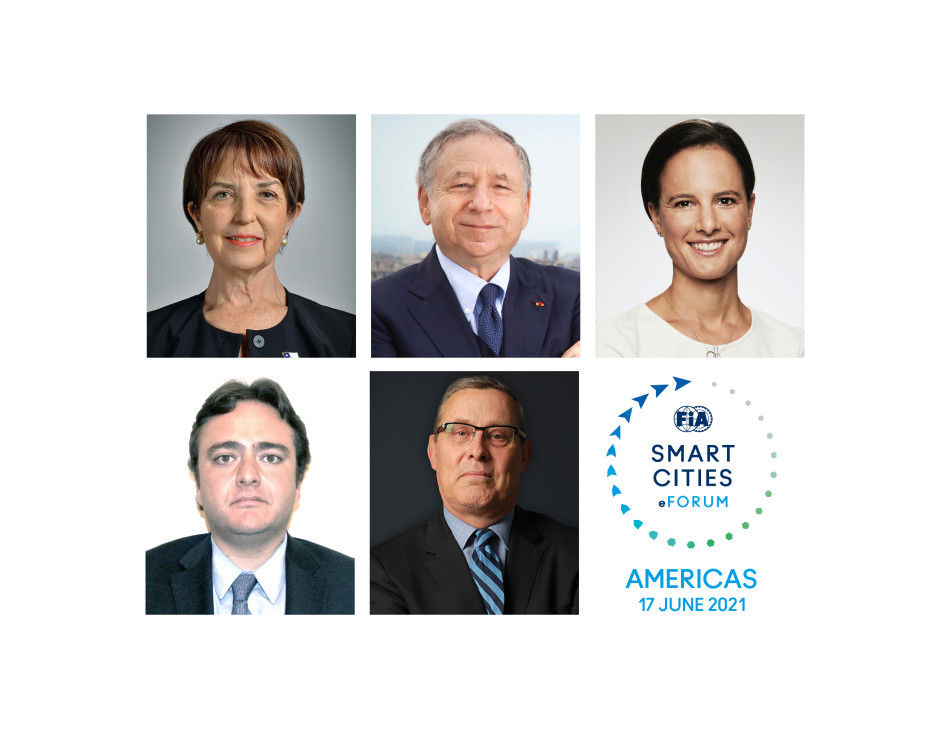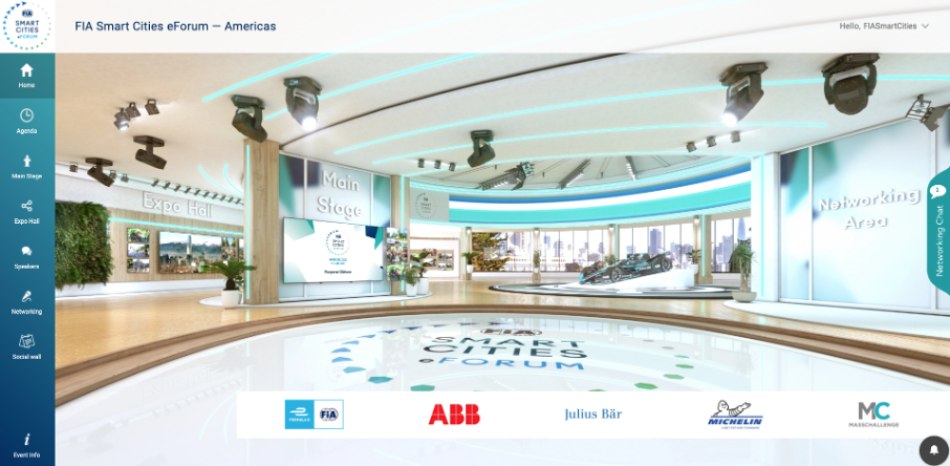FIA SMART CITIES eFORUM — AMERICAS: MICROMOBILITY AND MULTIMODALITY FOR A NEW URBAN TRANSPORT LANDSCAPE
Held on 17 June, the FIA Smart Cities eForum – Americas gathered urban mobility experts from all sectors to look at what the future holds for improved micromobility and multimodality services in the Americas region post-COVID-19.

FIA President Jean Todt welcomed the eForum participants and highlighted the FIA’s work, along with its Member Clubs to promote safer, more sustainable and more accessible mobility for all road users. He insisted on the importance of road safety in Latin America where approximately 50 percent of road fatalities involve motorcycle users. To address this and other motorcycle related fatalities around the world, he presented the FIA Safe & Affordable Helmet Programme, which aims to produce affordable and comfortable helmets that meet rigorous international safety standards. “With the support of its Member Clubs, and in coordination with national road safety agencies, the FIA launched the Safe & Affordable Helmet Programme in the Dominican Republic, Uruguay, Colombia, Paraguay and Costa Rica. This deployment is currently underway, and I am confident in saying it is one of the most promising innovations for road safety in Latin America and will change road safety in the region.”, said Todt. Jean Todt also mentioned several ways in which FIA Members Clubs assisted their local communities during the COVID-19 pandemic, highlighting their work in collaboration with the International Federation of the Red Cross and Red Crescent Societies.
Minister for Transport and Telecommunications of Chile Gloria Hutt then took the floor to present the Chilean government’s strategy to facilitate the deployment of electric mobility. Issued in 2017, this strategy is based on five pillars: regulation and standards; focus on public transport; research and development; a national plan to replace 40 percent of all private cars by electric vehicles and 100 percent of public transport by electric buses by 2040, and; information and communication. Hutt also touched upon the government’s efforts, together with the Ministries of Energy and Environment, to prepare a pilot project on hydrogen and autonomous driving vehicles. Hutt also highlighted the impact of COVID-19 on public transport in Chile, citing a 90 percent drop in demand during the crisis and the need to rebuild confidence during the recovery period.
Still on the topic of COVID-19 in Chile, ACCHI President Alejandro Quintana presented the profound impact of the crisis on the mobility landscape, which included: an increase in the sale of used cars and motorcycles; an increase in the use of bicycles; greater use of micromobility for last mile transport of people, goods and services, and finally; the emergence of a new working culture based on homeworking.
Even if the crisis is not over yet, Quintana highlighted the threats and opportunities created by the pandemic. “The main issues for improving micromobility and multimodality will be related to improving social inclusion and integration in cities. We need to democratise mobility. The priority will be to continue developing the multimodal transportation plan that shows a real modernisation for Santiago and other cities, and hopefully continue working on the transition from petrol to electric buses.”, said Quintana. The ACCHI President went on to emphasise the important role Automobile Clubs can play in Latin America, despite their relatively small size and limited resources. Their strong connection to their community means they have a valuable role in mobilising and driving change in mobility habits and behaviour. In particular, he mentioned the grassroots work of Automóvil Club de Chile in the fields of helmet safety and child safety.
Talking about Club contributions to help shape sustainable transport, ANA President Julian Abed explained that one of ANA’s most important tasks was to inform the public about the advantages and ecological impact of micromobility. He also highlighted the safety dimension: “The Club has to collaborate strongly with government mobility agencies to plan designated areas for micromobility to function safely, correctly to minimise the risk that daily users are confronted with on regular streets and sidewalks.” Abed presented three important projects ANA has been working on to improve road safety in Mexico: the 12-month programme called ‘Un impacto de vida’to promote awareness on key risk factors such as the use of turn signals, seatbelts and speed limits, the ‘Yo cuido a mis hijos’campaign on Child Restraint Systems and the FIA Safe & Affordable Helmet Programme.
The final speaker on the opening panel was Formula E Chief Strategy and Business Development Officer Hannah Brown, who explained how, from its inception, Formula E has aimed at shaping a decarbonised future, using sport to inspire new generations. She underlined Formula E’s investment in local legacy projects around sustainable energy production, as well as the importance of inclusion. Apart from the city centre location and affordable ticketing, Brown mentioned the FIA Girls On Track Programme bringing girls from the local community into the race environment. She concluded on Formula E’s will to reach more audiences, developing branding campaigns and using gaming platforms.

The eForum then moved on to the keynote session delivered by BloombergNEF Head of Intelligent Mobility Nick Albanese, who presented the key findings from the recently published BloombergNEF Long Term Electric Vehicle Outlook looking at the future of shared, electric and autonomous mobility through to 2040 on the markets all over the world.
Albanese started by highlighting how quickly the electric vehicle (EV) market has taken off over the past few years and how passenger EV sales have jumped and kept growing in 2020 despite COVID-19. Two key trends have been observed: the growth of EV sales is an increasingly global story, and most of the EV sales are now pure electric cars because governments are incentivising auto makers to shift their investment from plug-in electric hybrid cars to pure electric cars in most major auto markets around the world.
In addition to sales, Albanese explained that investment to support electrified transport development has also increased. Talking about these evolutions he said, “We are expecting these numbers to keep growing. If you look at 2020, EVs are already the sole growth market for the global automotive sector.”
“Looking ahead, it’s important to keep in mind though that EVs are still a small portion of total vehicle sales”, he added. Albanese explained that there are three important drivers for the development of EV sales: ‘Policy’, ‘Investment’, and ‘Economics’.
‘Policy’ because subsidies and tight regulations are still key to encouraging EV adoption as they remain expensive. For ‘Investment’, he referred to charging infrastructure as essential to enable the growth of the passenger EV market. And on ‘Economics’, Albanese mentioned that long term, the most important driver will be the price of batteries, which now accounts for 30-40 percent of the cost of battery electic vehicles. Key to this was EVs’ price-parity with ICE cars which, according to BloombergNEF data, is expected to occur by 2030.
Albanese highlighted that for North America, the fleet will turn over slowly and that by 2040 around 40-45 percent of total vehicles will be zero emission capable. To tackle climate change he reminded that additional policies are needed to jump-start the market. Relying on the current data, he explained that the EV sales curb would have to be advanced by five to fifteen years (depending on the market) if we wanted to have a fully zero emission global fleet by 2050.

In addition to having a positive impact on the electrification of transport, the pandemic also accelerated the development of two other major trends of mobility in Americas: multimodality and micromobility. To analyse these evolutions, the panel discussion gathering Movmi - Shared Transportation Services Founder and CEO Sandra Phillips, United Nations Environment Programme (UNEP) Electric Mobility Lead Jone Orbea, and Urbvan Head of Public Affairs Vicente Torres looked at “Making Cities Multimodal”.
Although micromobility has developed during the pandemic, Jone Orbea explained that three challenges still need to be addressed in order to embed these services in cities. The first one is ‘safety’. There is a need for tighter regulations to better protect bikes’ and scooters’ users and ensure their safety. The second one is ‘connectivity’. Micromobility shouldn’t necessarily be seen as an alternative to a mass transport system but more as something that can be used as part of a bigger scheme, as one mode that can be used to connect with other modes of transport. The last one, ‘inclusion’, refers to the need to think about how to make micromobility useful and accessible to all, including people with disabilities. The key issue at stake is “how can micromobility become something that is not only for young people, for people who can actually use a bike or a scooter, but also for people who need help to move around the city”, she said.
Orbea also highlighted how micromobility has contributed to the development of the electrification of transport and in fostering a new vision of transport. “It’s really interesting to see how associating micromobility with electric mobility can lead to new ideas and services,” she commented after having presented some of the projects developed in the region.
To make transport greener, she insisted on the need for the sector to move faster. “The transition must be coupled between the energy sector and the transportation sector. The energy sector has been advancing more than the transport sector. We have countries that have 80-90 percent of green energy production but we don’t see such a high percentage in the transport sector” she said.
Sandra Phillips also insisted on the need to make transport more sustainable and explained how micromobility and shared services are playing a key role in driving that change. “All forms of shared mobility, whether that’s micromobility, public transit or car sharing, use our ressources more efficiently,” she said. The shift away from the use of personal cars in cities has an impact on the urban space. As cars in cities are parked for about 23 hours per day, the decrease of their number frees space that can be allocated to the development of safe infrastructure, parking lots or bike lanes. However, even if our cities are changing and adapting to this new demand, the revolution of micromobility is not complete yet. According to Phillips, operating shared mobility services remains too difficult and challenging today and efforts should be made to support these new forms and enable them to be financially viable in the long term.
Talking about building better cities for tomorrow, Phillips explained that three lessons can be learnt from the pandemic: the first is that multimodal cities with more choice are more resilient; the second is that cities and transit authorities can benefit a lot from the data that is created by micromobility, but there is a need for this data to be joined up with smart data policy and the larger transportation system; and finally, agility is key when it comes to design and adaptation of transport infrastructure in cities as we have seen with the quick transformation of many urban spaces into emergency bike lanes. “If you want a resilient transport system going forward, you need more choice — don’t make one better than the other, just increase the choices, (…) and improve data exchange between the private and public sectors,” she declared.
The importance of choice was also emphasised by Vicente Torres from Urbvan, a start-up that won the Mexico City edition of the FIA Smart Cities Global Start-up Contest Season 4 and that offers a shuttle service operating on a network of express routes established according to customer demand. “All the cities with the highest level of competitiveness and quality of life indexes have made their transportation system a multimodal system that is not dependent on any particular transport mode. It’s not about only bikes, or only pedestrians, or only public transport, it’s about choices,” he said.
Torres explained that the service offered by Urbvan doesn’t compete with mass transport but rather gives another option to mobility users to complete the existing transport system.. Urbvan has been active to help meet that objective by adapting its services to the changes caused by COVID-19. Following the lockdowns, Urbvan had to show resilience and, as most people stopped using its main shuttle services because of homeworking, the start-up turned to companies and industries that needed a reliable and safe transport option for their employees to keep their activities running. Ubvan also developed new inter-cities services as they noticed that more and more people who used to live in the city centres decided to move away and needed long-distance shuttle services to come to work about twice a week.


The last part of the eForum gave the floor to KUHMUTE and Woocar, both winners of the Americas edition of the FIA Smart Cities Global Start-up Contest Season 5. KUHMUTE, winner for North America, provides a universal parking and charging solution for all kinds of micromobility electric vehicles. Woocar, winner for South America, develops and implements mobile telematics solutions for company, transport and government fleets to improve safe and sustainable driving.
The FIA Smart Cities eForum – Americas was the first conference of Season 5. Two other eForums will follow, each one with a regional focus: Europe on 22 July and Asia-Pacific in October.

 Facebook
Facebook Twitter
Twitter






